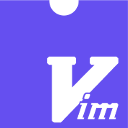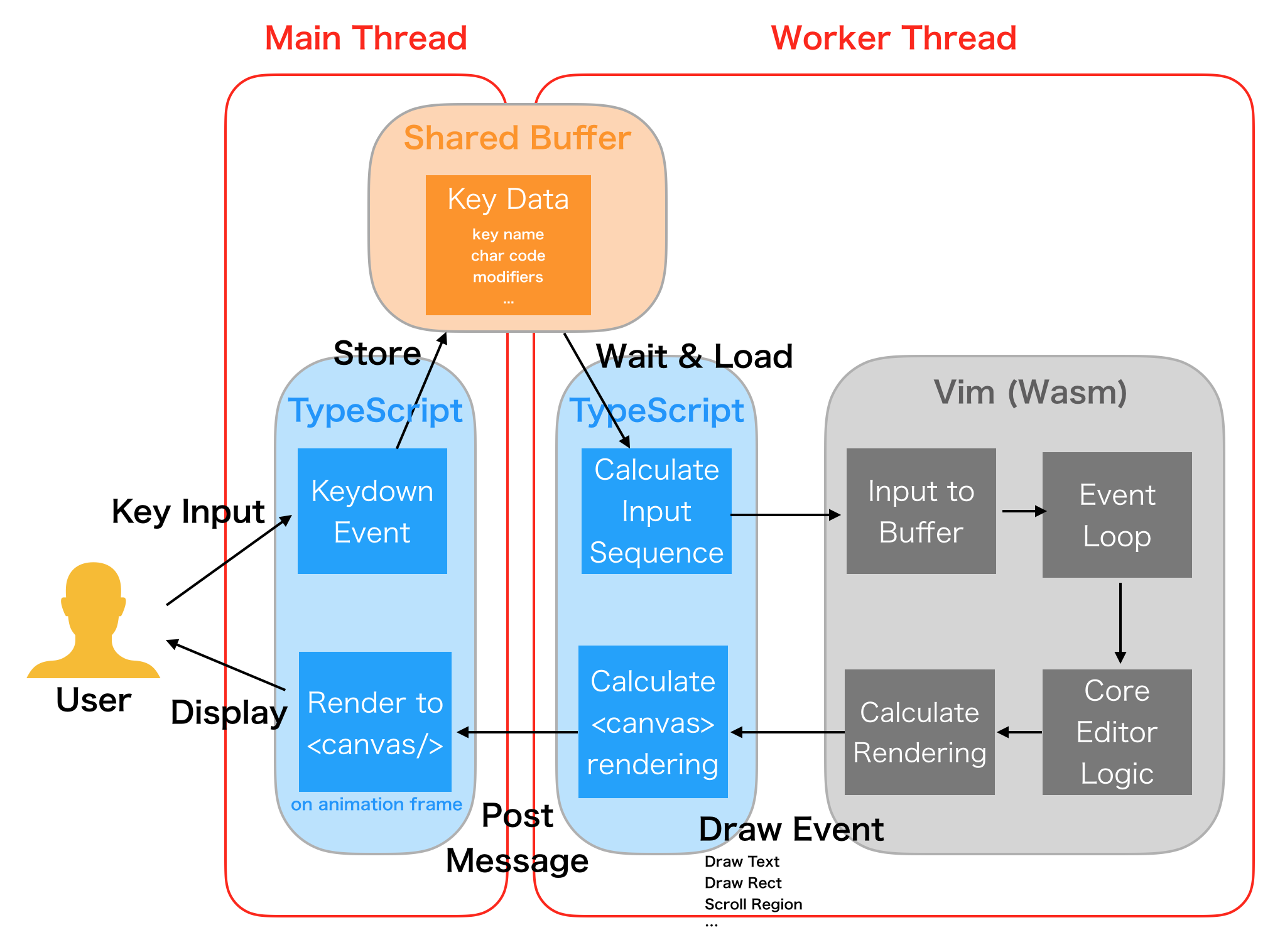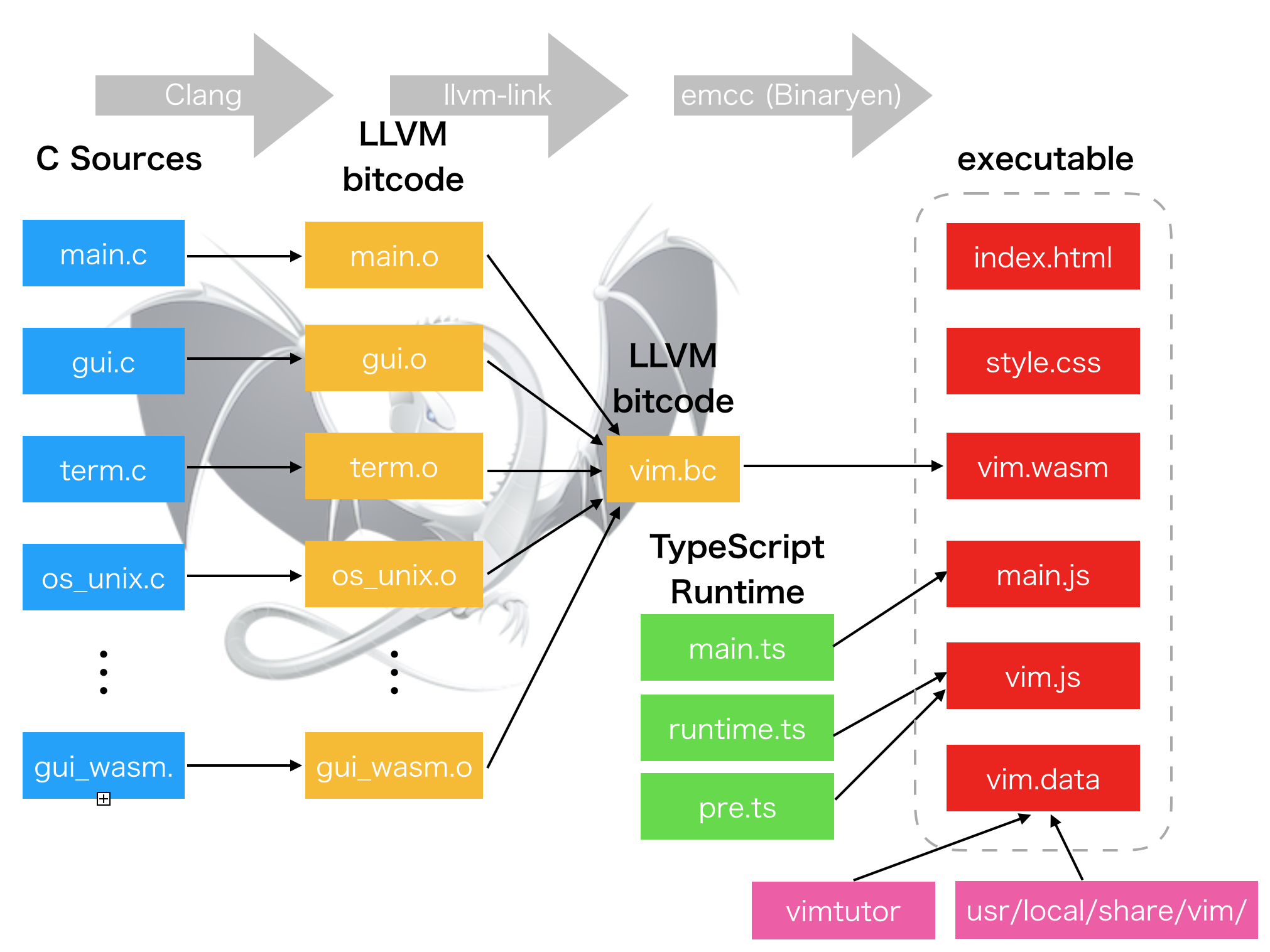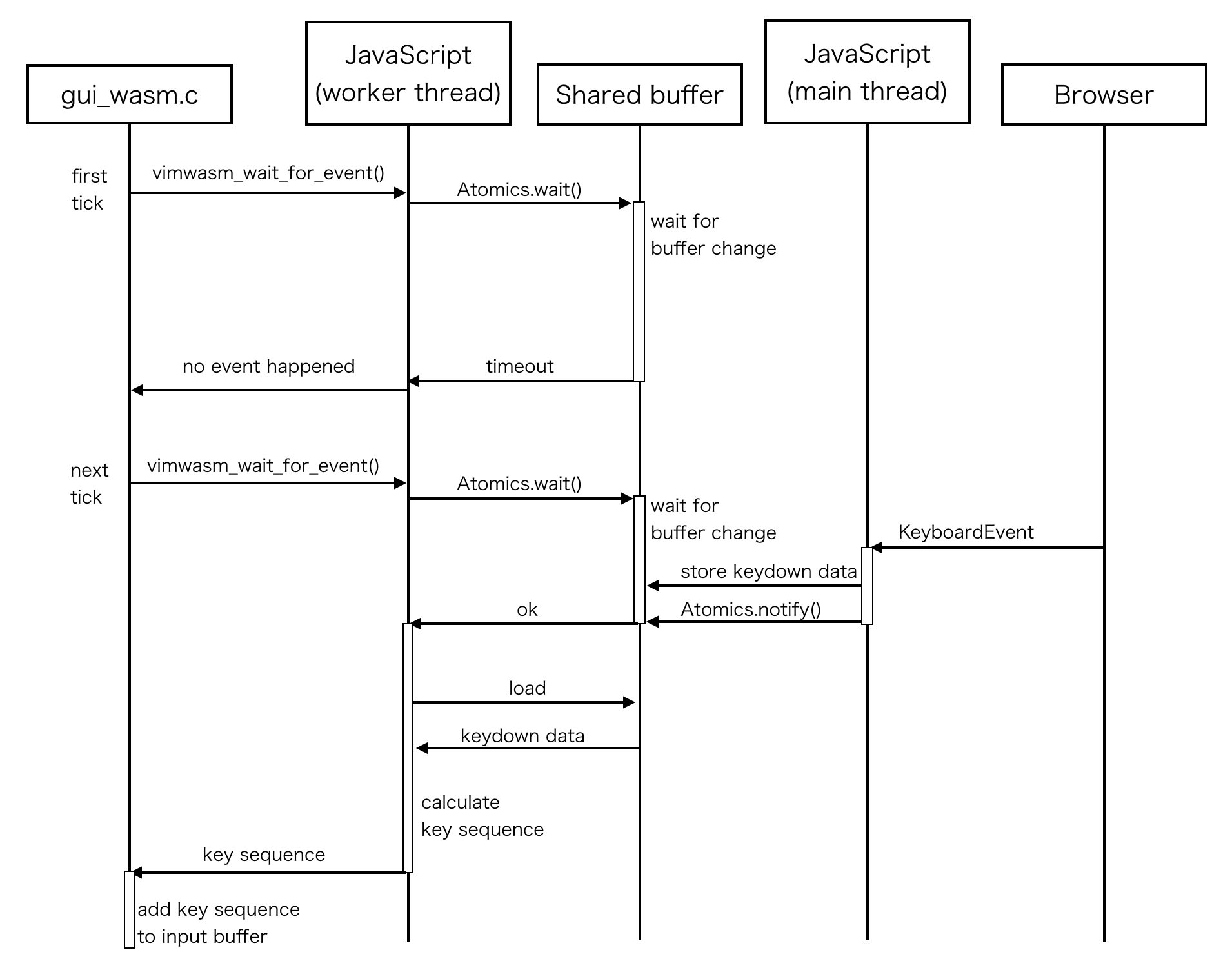This project is an experimental fork of Vim editor by @rhysd to compile
it into WebAssembly using emscripten and binaryen. Vim runs on Web Worker
and interacts with the main thread via SharedArrayBuffer.
The goal of this project is running Vim editor on browsers without losing Vim's powerful functionalities by compiling Vim C sources into WebAssembly.
-
USAGE
- Almost all Vim's powerful features (syntax highlighting, Vim script, text objects, ...) including the latest features (popup window, ...) are supported.
- Drag&Drop files to browser tab opens them in Vim.
:writeonly writes file on memory. Download current buffer by:exportor specific file by:export {file}.- Clipboard register
"*is supported. For example, paste system clipboard text to Vim with"*por:put *, and copy text in Vim to system clipboard with"*yor:yank *. If you want to synchronize Vim's clipboard with system clipboard,:set clipboard=unnamedshould work like normal Vim. - Files under
~/.vimdirectory is persistently stored in Indexed DB. Please write your favorite configuration in~/.vim/vimrc(NOT~/.vimrc). file={filepath}={url}fetches a file from{url}to{filepath}. Arbitrary remote files can be opened (care about CORS).- Default colorscheme is onedark.vim, but vim-monokai is also available as high-contrast colorscheme.
:!/path/to/file.jsevaluates the JavaScript code in browser.:!%evaluates current buffer.- vimtutor is available by
:e tutor. - Add
arg=query parameters (e.g.?arg=~%2f.vim%2fvimrc&arg=hello.txt) to addvimcommand line arguments. - Please read the usage documentation for more details.
-
NOTICE
- Please access from desktop Chrome, Firefox, Safari or Chromium based browsers
since this project uses
SharedArrayBufferandAtomics. On Firefox or Safari, feature flags (javascript.options.shared_memoryfor Firefox) must be enabled for now. - vim.wasm takes key inputs from DOM
keydownevent. Please disable your browser extensions which intercept key events (incognito mode would be the best). - This project is very early phase of experiment. You may notice soon on trying it... it's buggy :)
- If inputting something does not change anything, please try to click somewhere in the page. Vim may have lost the focus.
- Vim exits on
:quit, but it does not close a browser tab. Please close it manually :)
- Please access from desktop Chrome, Firefox, Safari or Chromium based browsers
since this project uses
This project is packaged as vim-wasm npm pacakge to be used in
web application easily. Please read the documentation for
more details.
The current ported Vim version is 8.2.0055 with 'normal' and 'small' features sets. Please check changelog for update history.
Following projects are related to this npm package and may be more suitable for your use case.
- react-vim-wasm: React component for vim.wasm. Vim editor can be embedded in your React web application.
- vimwasm-try-plugin: Command line tool to open vim.wasm including specified Vim plugin instantly. You can try Vim plugin without installing it!
- vim.wasm.ipynb: Jupyter Notebook integration with vim.wasm. Try it online!
In worker thread, Vim is running by compiled into Wasm. The worker thread is spawned as dedicated Web Worker from main thread when opening the page.
Let's say you input something with keyboard. Browser takes it as KeyboardEvent on
keydown event. JavaScript in main thread catches the event and store keydown
information to a shared memory buffer.
The buffer is shared with the worker thread. Vim waits and gets the keydown information
by polling the shared memory buffer via JavaScript's Atomics API. When key information
is found in the buffer, it loads the information and calculates key sequence. Via
JS to Wasm API thanks to emscripten, the sequence is added to Vim's input buffer
in Wasm.
The sequence in input buffer is processed by core editor logic (update buffer, screen, ...). Due to the updates, some draw events happen such as draw text, draw rects, scroll regions, ...
These draw events are sent to JavaScript in worker thread from Wasm thanks to emscripten's
JS to C API. Considering device pixel ratio and <canvas/> API, how to render the
events is calculated and these calculated rendering events are passed from worker thread
to main thread via message passing with postMessage().
Main thread JavaScript receives and enqueues these rendering events. On animation
frame, it renders them to <canvas/>.
Finally you can see the rendered screen in the page.
WebAssembly frontend for Vim is implemented as a new GUI frontend of Vim like other GUI such as GTK frontend. C sources are
compiled to each LLVM bitcode files and then they are linked to one bitcode file
vim.bc by emcc. emcc will finally compile the vim.bc into vim.wasm binary
using binaryen and generates HTML/JavaScript runtime.
The difference I faced at first was the lack of terminal library such as ncurses.
I modified configure script to ignore the terminal library check. It's OK since
GUI frontend for Wasm is always used instead of CUI frontend. I needed many
workarounds to pass configure checks.
emscripten provides Unix-like environment. So os_unix.c can support Wasm. However,
some features are not supported by emscripten. I added many #ifdef FEAT_GUI_WASM
guards to disable features which cannot be supported by Wasm (i.e. fork (2)
support, PTY support, signal handlers are stubbed, ...etc).
I created gui_wasm.c heavily referencing gui_mac.c and gui_w32.c. Event loop
(gui_mch_update() and gui_mch_wait_for_chars()) is simply implemented with
blocking wait. And almost all UI rendering events are passed to JavaScript layer
by calling JavaScript functions from C thanks to emscripten.
C sources are compiled (with many optimizations) into LLVM bitcode with Clang
which is integrated to emscripten. Then all bitcode files (.o) are linked to
one bitcode file vim.bc with llvm-link linker (also integrated to emscripten).
And I created JavaScript runtime in TypeScript to draw the rendering events sent
from C. JavaScript runtime is separated into two parts; main thread and worker
thread. wasm/main.ts is for main thread. It starts Vim in worker thread and
draws Vim screen to <canvas> receiving draw events from Vim. wasm/runtime.ts
and wasm/pre.ts are for worker thread. They are written using
emscripten API.
emcc (emscripten's C compiler) compiles the vim.bc and runtime.js into vim.wasm,
vim.js and vim.data with preloaded Vim runtime files (i.e. colorscheme) using
binaryen. Runtime files are loaded on a virtual file system provided on a browser
by emscripten. Here, these files are compiled for worker thread. wasm/main.js
starts a dedicated Web Worker loading vim.js.
Finally, I created a small wasm/index.html which contains <canvas/> to render
Vim screen and load wasm/main.js.
Now hosting wasm/index.html with a web server and accessing to it with browser
opens Vim. It works.
The hardest part for this porting was how to implement blocking wait (usually done
with sleep()).
Since blocking main thread on web page means blocking user interaction, it is basically prohibited. Almost all operations taking time are implemented as asynchronous API in JavaScript. Wasm running on main thread cannot block the thread except for busy loop.
But C programs casually use sleep() function so it is a problem when porting the programs.
Vim's GUI frontend is also expected to wait user input with blocking wait.
emscripten provides workaround for this problem, Emterpreter. With Emterpreter,
emscripten provides (pseudo) blocking wait functions such as emscripten_sleep().
When they are used in C function, emcc compiles the function into Emterpreter byte
code instead of Wasm. And at runtime, the byte code is run on an interpreter (on Wasm).
When the interpreter reaches at the point calling emscripten_sleep(), it suspends
byte code execution and sets timer (with setTimeout JS function). After time
expires, the interpreter resumes state and continues execution.
By this mechanism, JavaScript's asynchronous wait looks as if synchronous wait from C world. At first I used Emterpreter and it worked. However, there were several issues.
- It splits Vim sources into two parts; pure Wasm code directly run and Emterpreter byte code run on an interpreter. I needed to maintain large functions list which should be compiled into Emterpreter byte code. When the list is wrong, Vim crashes
- Emterpreter is not so fast so it slows entire application
- Emterpreter makes program unstable. For example JS and C interactions don't work in some situations
- Emterpreter makes built binary bigger and compilation longer. Compiling C code into Emterpreter byte code is very slow since it requires massive code transformations. Emterpreter byte code is very simple so its binary size is bigger
I looked for an alternative and found Atomics.wait(). Atomics.wait()
is a low-level synchronous primitive function. It waits until a specific byte in shared
memory buffer is updated. It's blocking wait. Of course it is not available on
main thread. It must be used on a worker thread.
I moved Wasm code base into Web Worker running on worker thread, though rendering
<canvas/> is still done in main thread.
Vim uses Atomics.wait() for waiting user input by watching a shared memory buffer.
When a key event happens, main thread stores key event data to the shared memory buffer
and notifies that a new key event came by Atomics.notify(). Worker thread detects
that the buffer was updated by Atomics.wait() and loads the key event data from
the buffer. Vim calculates a key sequence from the data and add it to input buffer.
Finally Vim handles the event and sends draw events to main thread via JavaScript.
As a bonus, user interaction is no longer prevented since almost all logic including entire Vim are run in worker thread.
Please make sure that Emscripten (I'm using 1.38.37) and binaryen (I'm using v84)
are installed. If you use macOS, they can be installed with
brew install emscripten binaryen.
Please use build.sh script to hack this project. Just after cloning this
repository, simply run ./build.sh. It builds vim.wasm in wasm/ directory.
It takes time and CPU power a lot.
Finally host the wasm/ directly on localhost with a web server such as
python -m http.server 1234. Accessing to localhost:1234?debug will start
Vim with debug logs. Note that it's much slower than release build since many
debug features are enabled. Please read wasm/README.md for
more details.
Please note that this repository's wasm branch frequently merges the latest
vim/vim master branch. If you want to hack this project, please ensure
to create your own branch and merge wasm branch into your branch by git merge.
WebAssembly nor JavaScript does not provideThis was fixed at #30sleep(). By default, emscripten compilessleep()into a busy loop. So vim.wasm is using Emterpreter which providesemscripten_sleep(). Some whitelisted functions are run with Emterpreter. But this feature is not so stable. It makes built binaries larger and compilation longer.JavaScript to C does not fully work with Emterpreter. For example, calling some C APIs breaks Emterpreter stack. This also means that calling C functions from JavaScript passing aThis was fixed at #30stringparameter does not work.- Only Chrome and Chromium based browsers are supported by default. Firefox and Safari
require enabling feature flags. This is because
SharedArrayBufferis disabled due to Spectre security vulnerability. This can be fixed with Asyncify. The work is in progress and tracked at PR #35.
Development is managed in GitHub Projects.
- Consider to support larger feature set ('big' and 'huge')
- Use WebAssembly's multi-threads support with Atomic instructions instead of JavaScript Atomics API
RenderCurrently not available. Please read notes.<canvas/>in worker thread using Offscreen Canvas- Mouse support
- IME support
- Packaging vim.wasm as Web Component
This project was heavily inspired by impressive project vim.js by Lu Wang.
All additional files in this repository are licensed under the same license as
Vim (VIM LICENSE). Please see :help license for more detail.
Original README is following.

For translations of this README see the end.
Vim is a greatly improved version of the good old UNIX editor Vi. Many new
features have been added: multi-level undo, syntax highlighting, command line
history, on-line help, spell checking, filename completion, block operations,
script language, etc. There is also a Graphical User Interface (GUI)
available. Still, Vi compatibility is maintained, those who have Vi "in the
fingers" will feel at home. See runtime/doc/vi_diff.txt for differences with
Vi.
This editor is very useful for editing programs and other plain text files. All commands are given with normal keyboard characters, so those who can type with ten fingers can work very fast. Additionally, function keys can be mapped to commands by the user, and the mouse can be used.
Vim runs under MS-Windows (NT, 2000, XP, Vista, 7, 8, 10), Macintosh, VMS and almost all flavours of UNIX. Porting to other systems should not be very difficult. Older versions of Vim run on MS-DOS, MS-Windows 95/98/Me, Amiga DOS, Atari MiNT, BeOS, RISC OS and OS/2. These are no longer maintained.
You can often use your favorite package manager to install Vim. On Mac and Linux a small version of Vim is pre-installed, you still need to install Vim if you want more features.
There are separate distributions for Unix, PC, Amiga and some other systems.
This README.md file comes with the runtime archive. It includes the
documentation, syntax files and other files that are used at runtime. To run
Vim you must get either one of the binary archives or a source archive.
Which one you need depends on the system you want to run it on and whether you
want or must compile it yourself. Check http://www.vim.org/download.php for
an overview of currently available distributions.
Some popular places to get the latest Vim:
- Check out the git repository from github.
- Get the source code as an archive.
- Get a Windows executable from the vim-win32-installer repository.
If you obtained a binary distribution you don't need to compile Vim. If you
obtained a source distribution, all the stuff for compiling Vim is in the
src directory. See src/INSTALL for instructions.
See one of these files for system-specific instructions. Either in the READMEdir directory (in the repository) or the top directory (if you unpack an archive):
README_ami.txt Amiga
README_unix.txt Unix
README_dos.txt MS-DOS and MS-Windows
README_mac.txt Macintosh
README_vms.txt VMS
There are other README_*.txt files, depending on the distribution you used.
The Vim tutor is a one hour training course for beginners. Often it can be
started as vimtutor. See :help tutor for more information.
The best is to use :help in Vim. If you don't have an executable yet, read
runtime/doc/help.txt. It contains pointers to the other documentation
files. The User Manual reads like a book and is recommended to learn to use
Vim. See :help user-manual.
Vim is Charityware. You can use and copy it as much as you like, but you are
encouraged to make a donation to help orphans in Uganda. Please read the file
runtime/doc/uganda.txt for details (do :help uganda inside Vim).
Summary of the license: There are no restrictions on using or distributing an unmodified copy of Vim. Parts of Vim may also be distributed, but the license text must always be included. For modified versions a few restrictions apply. The license is GPL compatible, you may compile Vim with GPL libraries and distribute it.
Fixing bugs and adding new features takes a lot of time and effort. To show your appreciation for the work and motivate Bram and others to continue working on Vim please send a donation.
Since Bram is back to a paid job the money will now be used to help children
in Uganda. See runtime/doc/uganda.txt. But at the same time donations
increase Bram's motivation to keep working on Vim!
For the most recent information about sponsoring look on the Vim web site: http://www.vim.org/sponsor/
If you would like to help making Vim better, see the CONTRIBUTING.md file.
The latest news about Vim can be found on the Vim home page: http://www.vim.org/
If you have problems, have a look at the Vim documentation or tips: http://www.vim.org/docs.php http://vim.wikia.com/wiki/Vim_Tips_Wiki
If you still have problems or any other questions, use one of the mailing lists to discuss them with Vim users and developers: http://www.vim.org/maillist.php
If nothing else works, report bugs directly: Bram Moolenaar Bram@vim.org
Send any other comments, patches, flowers and suggestions to: Bram Moolenaar Bram@vim.org
This is README.md for version 8.2 of Vim: Vi IMproved.





